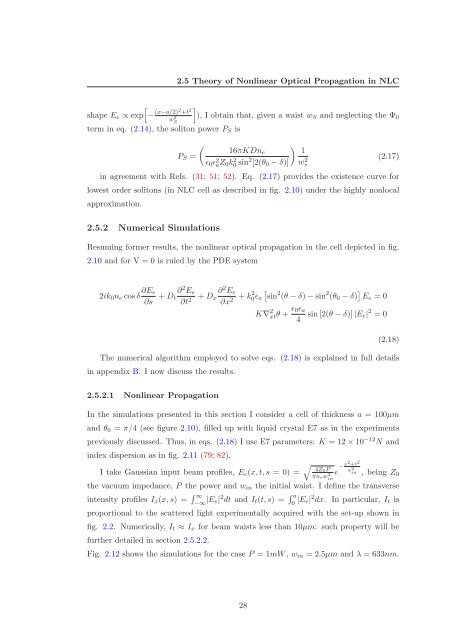Solitons in Nonlocal Media
Solitons in Nonlocal Media
Solitons in Nonlocal Media
Create successful ePaper yourself
Turn your PDF publications into a flip-book with our unique Google optimized e-Paper software.
shape Ee ∝ exp<br />
− (x−a/2)2 +t 2<br />
w 2 S<br />
term <strong>in</strong> eq. (2.14), the soliton power PS is<br />
2.5 Theory of Nonl<strong>in</strong>ear Optical Propagation <strong>in</strong> NLC<br />
<br />
), I obta<strong>in</strong> that, given a waist wS and neglect<strong>in</strong>g the Ψ0<br />
<br />
16πKDne<br />
PS =<br />
ǫ0ǫ2 aZ0k2 0 s<strong>in</strong>2 <br />
1<br />
[2(θ0 − δ)]<br />
w 2 s<br />
(2.17)<br />
<strong>in</strong> agreement with Refs. (31; 51; 52). Eq. (2.17) provides the existence curve for<br />
lowest order solitons (<strong>in</strong> NLC cell as described <strong>in</strong> fig. 2.10) under the highly nonlocal<br />
approximation.<br />
2.5.2 Numerical Simulations<br />
Resum<strong>in</strong>g former results, the nonl<strong>in</strong>ear optical propagation <strong>in</strong> the cell depicted <strong>in</strong> fig.<br />
2.10 and for V = 0 is ruled by the PDE system<br />
2ik0ne cos δ ∂Ee<br />
∂s<br />
+ Dt<br />
∂2Ee ∂<br />
+ Dx<br />
∂t2 2Ee ∂x2 + k2 2 2<br />
0ǫa s<strong>in</strong> (θ − δ) − s<strong>in</strong> (θ0 − δ) Ee = 0<br />
K∇ 2 xtθ + ǫ0ǫa<br />
4 s<strong>in</strong>[2(θ − δ)] |Ee| 2 = 0<br />
(2.18)<br />
The numerical algorithm employed to solve eqs. (2.18) is expla<strong>in</strong>ed <strong>in</strong> full details<br />
<strong>in</strong> appendix B. I now discuss the results.<br />
2.5.2.1 Nonl<strong>in</strong>ear Propagation<br />
In the simulations presented <strong>in</strong> this section I consider a cell of thickness a = 100µm<br />
and θ0 = π/4 (see figure 2.10), filled up with liquid crystal E7 as <strong>in</strong> the experiments<br />
previously discussed. Thus, <strong>in</strong> eqs. (2.18) I use E7 parameters: K = 12 × 10 −12 N and<br />
<strong>in</strong>dex dispersion as <strong>in</strong> fig. 2.11 (79; 82).<br />
I take Gaussian <strong>in</strong>put beam profiles, Ee(x, t, s = 0) =<br />
4Z0P<br />
πnew 2 <strong>in</strong><br />
e − x2 +t 2<br />
w 2 <strong>in</strong> , be<strong>in</strong>g Z0<br />
the vacuum impedance, P the power and w<strong>in</strong> the <strong>in</strong>itial waist. I def<strong>in</strong>e the transverse<br />
<strong>in</strong>tensity profiles Ix(x, s) = ∞<br />
−∞ |Ee| 2 dt and It(t, s) = a<br />
0 |Ee| 2 dx. In particular, It is<br />
proportional to the scattered light experimentally acquired with the set-up shown <strong>in</strong><br />
fig. 2.2. Numerically, It ≈ Ix for beam waists less than 10µm: such property will be<br />
further detailed <strong>in</strong> section 2.5.2.2.<br />
Fig. 2.12 shows the simulations for the case P = 1mW, w<strong>in</strong> = 2.5µm and λ = 633nm.<br />
28
















